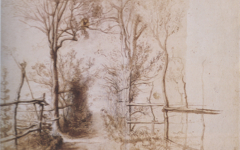Rembrandt and the Artist’s Gold Chain
Honor and their status in society was always an important issue for artists. As early as 1435 the art theorist L.B. Alberti was emphasizing the “divine power” of painting, “its moral worth and the high social status of its practitioners." He based his claim on ancient precedents noting that:
“Painting was honored by our ancestors with this special distinction that, whereas all other artists were called craftsmen, the painter alone was not counted among their number.”
Nevertheless, most artists in the early Renaissance were considered craftsmen so any honor conferred on them by a ruler immediately elevated the individual artist to a rarified realm. Vasari reports how in the fifteenth century Gentile Bellini went to Constantinople, was received by the Sultan with “great honor” and was given a gold chain.
After Titian painted himself wearing one or more gold chains in several self-portraits, the chain quickly became a symbol of an artist’s stature. Vasari, Bandinelli, Rubens and Van Dyck all painted their self-portraits wearing a gold chain. Rembrandt, on the other hand, in the Dutch Republic had no royal patrons and could only depict the honor due to him as a great master fictitiously.
His depiction of Lucretia, discussed in a separate entry, is a good example. In stabbing herself, she “paints” herself but, also, as an alter ego of Rembrandt, she wears a gold chain as a mark of his stature.
Click next thumbnail to continue
The identity of the figure in a painting known as Aristotle Contemplating the Bust of Homer is in dispute but, whether Aristotle or Apelles, the most famous Greek painter in Antiquity, the underlying meaning is similar. Rembrandt as “Aristotle or Apelles” touches (and thus “paints”) the head of Homer as “a work of art” while wearing the gold chain as a mark of both Rembrandt's and Aristotle's (or Apelles') distinction.
Click next thumbnail to continue
The equally fictitious gold chain around his son’s neck in Portrait of Titus indicates again that Titus is a self-representation of his artist-father.
Click next thumbnail to continue

Far Left: Rembrandt. Hendrijke Stoffels (c.1654-9)
Top: Detail of Hendrijke Stoffels
Bottom: Detail of Rembrandt's Self-Portrait with a Gorget (c.1629)
Click image to enlarge.
Hendrijke Stoffels was Rembrandt's mistress but he posed her here looking so like his self-portrait from thirty years earlier that she must be a female alter ego of Rembrandt. That then makes sense of the gold necklace which she probably did not own in life but wears here as a mark of Rembrandt's distinction and not her own. Her hand rests on the arm of the chair as though it was a sceptre.
Click next thumbnail to continue
Belshazzar’s Feast is a more complex painting. Nevertheless Belshazzar again wears the gold chain of a great master. Gold chains were, of course, given to people in many fields but when such a chain appears in the work of a great master, it is almost always – on the underlying level – a reference to the artist himself.
See conclusion below
Rembrandt’s interest in chains and his evident desire for one is somewhat touching considering how honored his contemporary and rival Rubens was in neighboring Flanders. Rubens traveled all over Europe receiving several gold chains and an English knighthood. Yet even though Rembrandt hardly ever traveled and never gained a royal commission, the gold chain shone in his mind and in his art as a symbol of the honor due to him as a great master.
More Works by Rembrandt, Rubens
Learn how a mythological scene represents the anatomy of the brain/mind

Rubens’ Perseus Freeing Andromeda (c. 1622)
Notes:
Original Publication Date on EPPH: 20 Feb 2011. | Updated: 0. © Simon Abrahams. Articles on this site are the copyright of Simon Abrahams. To use copyrighted material in print or other media for purposes beyond 'fair use', you must obtain permission from the copyright owner. Websites may link to this page without permission (please do) but may not reproduce the material on their own site without crediting Simon Abrahams and EPPH.






